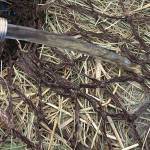Personal Particulate Monitor Proves Soaking Hay for Horses Worthwhile

Equine asthma can be triggered following exposure to allergens such as bacterial toxins, pollen, mites, fungal spores, or even plastic particles found in your horse’s habitat. Large volumes of dust and allergens are released from hay, which is often the bulk of a stabled horse’s diet. Allergen avoidance is recommended for asthmatic horses, but dodging all aerosolized dust particles is notoriously challenging in environments like barns that are cleaned daily.
Steaming and soaking hay are management tools employed to decrease dust when feeding horses with equine asthma. For example, steaming reportedly reduces the number of respirable dust particles in a horse’s breathing zone, considered to be the two-foot sphere around the horse’s nostrils.
“Studies show, however, poor compliance by owners over time with these management changes. This means that owners may initially make the recommended changes to reduce dust exposure when their horse is first diagnosed or following a flare-up requiring veterinary attention. But, as time passes, owners tend to stray from strategies, such as soaking hay, resorting instead to old habits,” explained Ashley Fowler, Ph.D., a nutritionist from Kentucky Equine Research.
Even though steaming or soaking hay is simple, practical, and involves minimal cost, it is more time-consuming and messier than simply throwing a horse a dry flake or two. Plus, the leftover water must be disposed of properly.
According to a team of veterinary researchers led by preeminent asthma researcher Laurent Couëtil, D.V.M., Ph.D., a device called a “personal particulate matter monitor” may help owners stay motivated.*
This device, which is mounted on a halter, measures minute, aerosolized particles measuring less than 1 micrometer (0.00003937 inches).
The researchers describe these devices as “low-cost, compact, real-time PM [particulate matter] monitors that have the potential to greatly facilitate personal exposure assessments.”
The research team compared the performance of the wearable PM monitor to a conventional fridge-sized PM unit. A strong correlation was observed in the ability to measure aerosolized particles generated from hay between the two types of monitors. The personal PM monitor, however, significantly underestimated the concentrations of particles measuring 2.5 and 10 micrometers.
“Nevertheless, the personal PM monitor still demonstrated that soaking hay resulted in a two- to threefold reduction in exposure to airborne particulates measuring 2.5 and 10 micrometers,” Fowler said.
She added, “Thus, these personal PM monitors can help owners stay motivated by being able to see firsthand the effect that soaking hay and other dust-reduction strategies are making.”
The researchers pointed out that while this particular study did not take any measurements to further characterize respiratory health, previous studies showed that feeding soaked hay for six weeks improved lung function in horses with severe asthma.
“In addition to soaking hay, additional ways of improving lung function in horses with asthma include offering DHA, a specific long-chain polyunsaturated omega-3 fatty acid. According to the most recent consensus guidelines, also authored by Couëtil, horses with asthma should be offered 1.5 g of DHA per day to help decrease inflammation,” shared Fowler.**
EO-3, marine-derived source of DHA, is a preferred omega-3 supplement, as it provides DHA and EPA (another important long-chain polyunsaturated fatty acid) directly, meaning the horse’s body does not need to convert ALA (as found in plant-based products like flax) to DHA and EPA before it derives benefit from it.
*Ivester, K.M., J-Q Ni, L.L. Couetil, T.M. Peters, M. Tatum, L. Willems, and J.H. Park. 2024. A wearable real-time particulate monitor demonstrates that soaking hay reduces dust exposure. Equine Veterinary Journal:14425
**Couëtil, L.L., J.M. Cardwell, V. Gerber, J.-P. Lavoi, R. Leguillette, and E.A. Richard. 2016. Inflammatory airway disease of horses—Revised consensus statement. Journal of Veterinary Internal Medicine 30(2):503-515.








